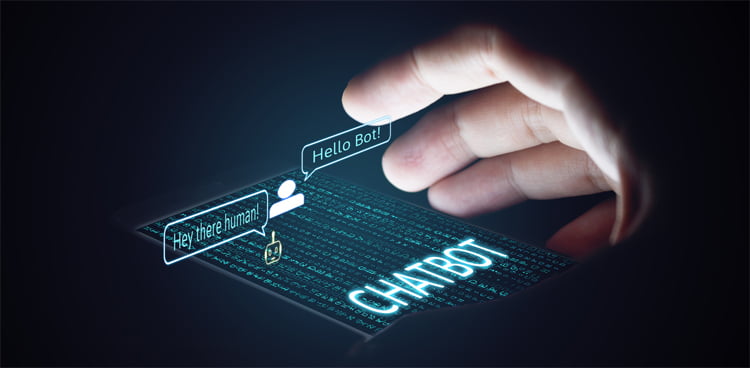While you are waiting for a human, try me!
February 13th, 2018 by Heather MaloneyIn the last year or so, due to the increased use of online chat, including Facebook Messenger and Slack, chatbots have become much more common. Chatbots are computer programs which interact with a customer in response to information he/she types into a chat tool / instant message program. The increased use of chatbots has lead to maturing of the tools to create chatbots, providing an opportunity for your business to utilise bots not just to provide faster help for customers with problems, but also to support sales enquiries.

Why would a customer be willing to interact with a bot?
The prime benefit for a customer is to get their problem solved or question answered more quickly. No matter how many people are added to a customer service team, there will always be times of peak enquiry where you have to wait to talk to a human.
Why wouldn’t a customer want to use a bot?
The most likely reason people would rather talk to a human is because they feel that it is harder to get their problem across to the computer, and because of that, it’s a more frustrating process and less likely to result in a satisfactory answer compared to talking to a person, whether by chat or by voice.
What to do?
To overcome the hesitation of people to use chat bots, several strategies have been used in the past including:
- Forcing users to first use the bot – Making the first interaction/s or all interactions in your online chat tool orchestrated by the bot, and not accessible by a human, with the option after a period of time attempting to solve the problem, pointing the customer to way to get to other support options. A similar strategy was used in the past with knowledge base functionality, whereby a person submitting a support request via a form was directed to first search the knowledge base, and only then after searching, were they given the option to submit a question.
- Pretending to be human – giving the bot human qualities, like attempting personality and humour, and giving them a human-like avatar or photo.
Neither of these strategies are very successful. People know when they are talking to a person, so trying to pretend otherwise can be felt as offensive to the intellect. Forcing people to use a bot first, again adds to the frustration of getting a result.
I believe that both chat and bots have their place in the provision of customer service. If I can get further information about a product I am considering via online chat, I am more likely to buy. It’s great knowing that I can just jump onto a chat within a website or web application, ask a question, and get an answer without having to dial up, sit in a telephone queue, and finally get through to a person. If on the way to getting my chat question answered, a bot steps in to try and help me get my solution more quickly, then I’m fine with that too, as long as I can differentiate the two types of assistance, and I can choose to ignore the advice of the bot and still get to chat to a real person, even if that takes longer.
Chatbots are great to help organisations provide 24/7 support, attempting to answer the question when an operator isn’t available, but allowing a person to take over the enquiry when the next support shift starts.
Steps to Creating a Useful Bot
When a human provides customer service the first step is to understand the enquirer’s problem. If they have heard the problem before, a proficient customer service operator can very quickly rectify the problem or provide the right guidance to the customer. Understanding the problem, of course, relies on the customer describing the problem in a way that’s understandable by the customer service person. And therein lies the difficulty. People describe the same problem in a myriad ways because they don’t always understand the nature of the problem themselves.
Take someone who has forgotten their password as an example. Whilst you may think most people would understand how to describe that in the fewest number of words, those who are less technically savvy might not realise that’s their problem. They may instead report that as “I can no longer login to your system”. In such a situation, a human being knows to quickly ask questions based on the statements made by the customer, and will glean clues from their tone and manner and the way they say those words. The customer service person could ask “okay, did you type in your username and password?” or they might say “when was the last time you logged in?” The answers provided by the customer will allow the support person to discover the root cause of the caller’s issue. If a bot is to determine the cause of a customer’s problem and the best solution, it needs to be able to interact with the customer and know the right questions to ask based on the way that a person communicates the problem. This is the challenge of programming a bot.
Step 1: Choose the Most Common Problems
Because it is challenging to program around the issues that people have, the first step when creating a new bot is to choose the most common problems or most frequently asked questions, that your customer service team currently deal with. Issues such as forgetting your password are unlikely to be the most common problems reported to your team, as such issues are likely already made easy for the customer to solve on their own. However, there will be issues that occur over and over, or questions raised on a regular basis, that you will be able to identify and solve, even if that is by pointing the customer to the right help article. Look for common categories of problems, as well specific issues and questions that re-occur.
Step 2: Document how people describe the problem
In order to program a bot to assist customers with a particular problem, you need to identify all the common ways that a person may describe the same problem. That’s when they actually know what the problem is. For example for those who realise that they have forgotten their password, there are still many different ways that a person may say that. They may say “I don’t know my password”. Or “I have forgotten my password”. Or “I have forgotten my login details”. Or “I don’t know what my password is”. Or “I need a new password”. Or “I have lost my password”. Or “Please reset my password”. These may not sound that different to a human, but to a simple computer program, they have similarities but they are all different.
You are likely to find that the one statement by a customer could actually require different solutions depending on their answers to other questions. Back to our password problem, if a user says “I can’t login” then the next question might be “Have you forgotten your password?” if the answer is no, then the next question might be “Have you forgotten your username?” and may lead to yet further questions. If the answer is yes, then the answer may have reached the end of the logical decision tree, ready for the solution.
As you document the questions that may be asked in order to discover the actual problem, you are likely to identify other questions and problems that you can solve along the way. You will need to decide how much time you will spend on these other problems based on how common they are, but at the same time, you don’t want to leave the customer hanging.
Step 3: Determine how the bot will direct the customer in order to solve the problem, or answer the question
Once you’ve worked out all the different ways a support request could be phrased by a customer and the questions you need to ask to get to the root of the problem, then you need to work out how the bot should respond. In the case of a password reset being required you may then program the bot to provide the password reset link. A password reset is a very simple problem to solve. The most common problem for you maybe something much more complicated.
The solution could be one or more of: providing a link to a help article which explains how to carry out a task, suggesting a list of possible products that meet the customer’s requirements, providing a link to a step by step screen overlay guiding the user through solving a particular problem, or staying in the chat in order to wait for a human to help.
Step 4: Test
Having programmed your bot to handle some common problems, it is now really important to test it with customers. You will gather much information about how useful it is by looking at your customer’s interaction with it.
If you give your customers the ability to rate the support they received or the help article you delivered to them, they actually may not choose to rate you, but you should still be able to see if they then needed to ask another question, or the same question in a different way.
Step 5: Refine and Extend
You should expect to continue to build on the list of questions or ways that a customer can ask about a particular problem. Over time you will also find the problems that are coming out the other end and not solved by the bot become your new most common problems. As I mentioned not all customers will be comfortable chatting, or chatting with a bot, so multiple support options should be provided.
Where can I place my bot?
Chatbots can be added into your mobile app, web application or website, but also into your Facebook page, Slack and other chat tools that are being used by your business. Where you will place your bot will help you select the tools you use to build it.
If you need help working through the process of creating a bot for your organisation, we would be very pleased to help.







